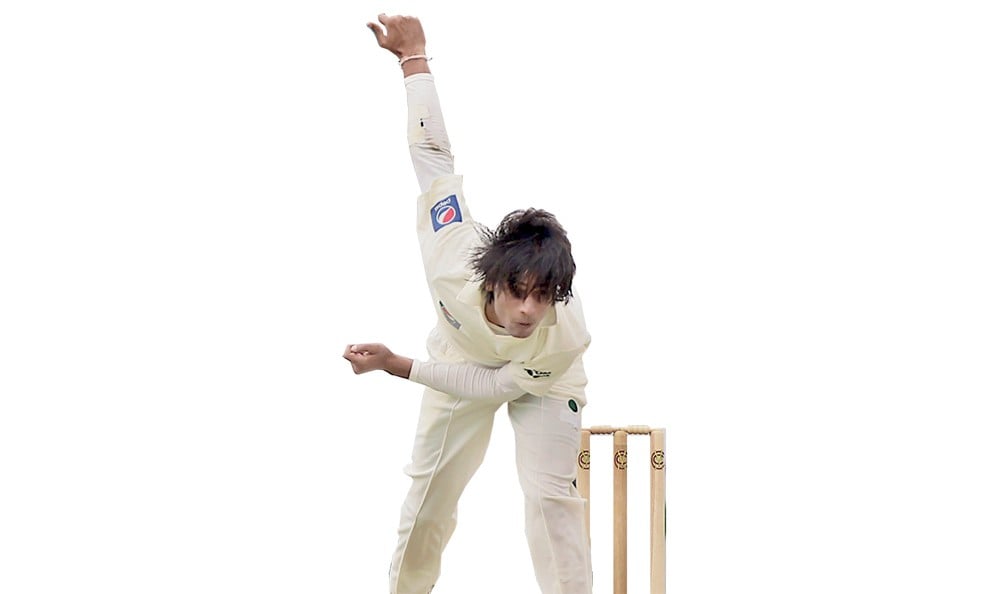
The young man has learned a hard lesson and is adhering to PCB and ICC instructions in true letter and spirit

Born on the unlucky 13th (April 1992), Muhammad Amir entered the international Cricket scene with a bang against Sri Lanka, at the age of 17. His contribution in 2009 ICC World T-20 was phenomenal. With a total of 99 international wickets in all the three types of Cricket formats the left arm pacer was implicated in spot fixing allegations in August 2010.
Justice Cooke described Amir as "unsophisticated, uneducated and impressionable a vulnerable junior in a very hierarchical environment", who can be "readily leaned on by others". What else could you expect from an eighteen years rookie, who is youngest of the seven siblings hailing from village Changa Bangial of Gujjar Khan.
At that time the young Amir was consistently bowling at the speed of above 145 KM/ hour and swinging the Cricket ball both ways, thus surprising the world top batsmen with his shrewdness and control over the leather. In the summer of 2010, Amir was awarded the man of the match award for becoming the youngest player ever to take five wickets haul in England. He also became the youngest player in Cricket history to take 50 test wickets. Cricket experts had predicted even a brighter future for the rookie bowler then the legendry Waseem Akram.
The rise of young star was sudden but the unlucky 13 was leaned on by others in the dirty spot fixing during the England series of 2011 and was convicted along with Salman Butt and Muhammad Asif in Nov 2011. Amir was served with six month prison sentence in the juvenile jail and was released after three months at the basis of good conduct on 01 February.
This was the time of transformation in the life of Amir, who was shattered emotionally and psychologically due to this incident. His brief stay in juvenile jail was a blessing in disguise, as he showed perfect level of remorse and fully cooperated with ACSU’s education programme.
The entire focus in Amir’s life had shifted from crafty fast bowling to the development of life skills in the juvenile jail in a constructive manner. Thanks to his mentors, well-wishers and lawyers who guided him very well and thanks to Amir for his positive response.
That was the time when Amir realized that money matters but character matters the most. He realized the value of truth, community and the nation he represents, not only as a Cricketer, but an ambassador on behalf of twenty million people. He realized how quickly love and respect can be lost in the eyes of admirers and how difficult it is to build your lost reputation.
In this desperate situation sports came at his rescue. He understood the debt he owes to the game and decided to face the outcome with patience and determination. While he was facing extreme criticism from many Pakistani critiques like Rameez Raja and Sikander Bakht for the reason better known to them, those who understood the socio psychological angles better, supported the young lad.
Michael Atherton in an article for the News of the World, asserted that Amir is an asset to the game of Cricket and considering his age and immense talent the ICC should take a lenient view of his offence. The same kind of support came from other leading Cricketers including Waseem Akram and South African bowler Henry Williams.
One of my very close associate in a leading Indian newspaper informed that many great Indian Cricketers, though not publically but privately supported Amir’s return to International Cricket sooner than later.
There is a need to understand that Amir’s case is different from Salman and Asif the repeated offender. Despite all this, a nexus is working against Amir’s return to international Cricket led by Rameez who has shown soft corner for West Indian Marlon Sameuls but surprisingly opposed Amir’s return to International Cricket.
Though ICC has kept the details of Amir’s rehabilitation and education as a secret but Amir’s cooperation with Anti-Corruption & Security Unit (ACSU) in the production of educational video and other related aspects of enquiry resulted in the support of ICC Chief Executive David Richardson, who said that "Like Hansie Cronje, people who have courage can change their future & Amir will do the same to turn around his future"
Amir has started participating in domestic Cricket under the ICC revised law. In the Super 8 T-20 group match representing Rawalpindi Rams Amir bamboozled Abbottabad Falcons opening batsman Sajjad Ali on the very first in swinging delivery that went through his middle stump, this must have sent a very strong signal to many present and past opening batsmen in the Cricketing world that brilliance is an asset that can rust temporarily but never die.
PCB has consistently recommended Amir to avoid media as he is still serving a five year ban for spot fixing and any slip of tongue or controversial comment could land him into trouble.
The young man has learned a hard lesson and is adhering to PCB and ICC instructions in true letter and spirit. I am myself a strong disciplinarian and had there been an iota of doubt in my mind that Amir has not learnt any lesson from this tragic episode I would have opposed Amir’s return to Cricketing world.
But seeing the circumstances I strongly feel that Amir must be given another chance to represent his country in International Cricket to not only prove his Cricketing brilliance but also his character, that has been tarnished in such a young and impressionable age. But the question arises that who will convey the sports media godfathers to stop Amir’s bashing without understanding its implications in the days to come.